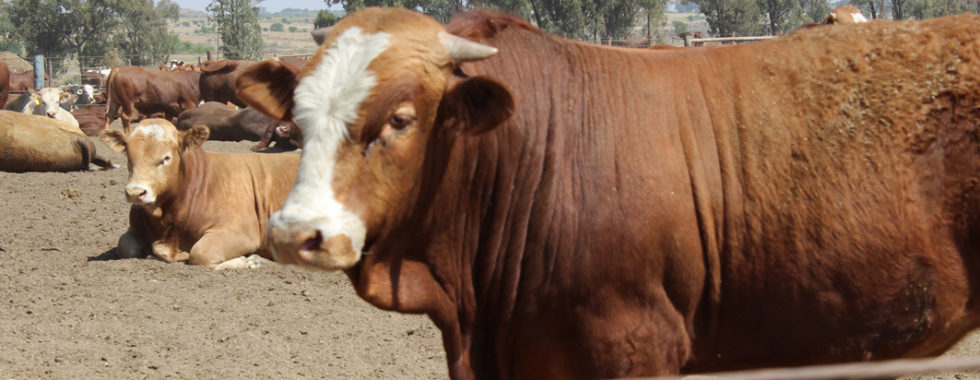The Protein Ruminant Puzzle
Author: Prof Izak Groenewald
Livestock producers in South Africa are familiar with the traditional seasonality in ambient temperatures, distribution of rainfall and the effect thereof on the growth pattern and quality of natural pastures. In real terms, the live mass of livestock follow a similar seasonal pattern with approximately six mass of live mass gains and six months of live mass loss. The latter is brought about by a decline in digestibility of the natural grass to levels below that which would support maintenance of body reserves. This ultimately leads to impaired biological and economical livestock production. The cause : effect is the starvation of the micro-organisms in the rumen, retarding their ability to digest the cellulose (fibre) of the ingested dry grasses.
Non-protein-nitrogen (NPN)
Micro-organisms respond positive to nitrogen (N). As this mineral is deficient in dry winter grass, any form of N supplementation will enhance their efficacy. Basic N supplementation comes in the form of non-protein-nitrogen (NPN) via products like urea or ammonium salts (ammonium sulphate, ammonium chloride, mono-ammonium phosphate). These NPN products are hydrolyzed in the rumen, releasing readily available N in the form of ammonia which “feed” the micro-organisms and enable them to digest the ingested fibrous material more efficiently. However, should large amounts of NPN are consumed and large amounts of ammonia be produced, it might exceed the capacity of the micro-organisms to capture it in which case the free ammonia will be absorbed in the blood system causing what is known as urea poisoning and death. NPN is thus the cheapest form of N supplementation but within limits. It should be used responsibly.
Natural protein rich products
Natural proteins could be of animal or plant origin. The latter are mostly derived from different oil cake meals (sunflower, cotton and soya bean) containing 40% or more crude protein or gluten 60 from plant origin. Whereas NPN are totally and rapidly hydrolyzed in the rumen, some natural proteins favor digestion in the rumen whilst others are more readily digested and absorbed in the small intestines. Through the years different nomenclature was used like biological values or digestibility of proteins. More recently natural proteins are grouped as rumen degradable or rumen undegradable protein indicating the cite of absorption. This is of utmost importance when lick supplement or complete feeds are formulated for specific applications.
Lick supplementation
Research has shown that most of the N supplied via lick supplements to ruminants could be derived from NPN emphasizing the relative importance of readily available N in the rumen for the microbes to digest the ingesta. However, ruminants are not all the time in a neutral production state and certain biological phases like wool production, milk production and pregnancy would necessitate the incorporation of natural proteins and more specific rumen undegradable proteins. The building blocks of proteins are amino acids and specific amino acids are required for specific production phases e.g. suplhur containing amino acids for wool production. It is therefore advisable to consult a registered animal scientist should you wish to blend your own lick supplements.
The road map and destination of strategical lick supplementation to free ranging ruminants can be summarized as follow:
- Rumen microbes require readily available N to enhance their efficacy
- The ingested dry winter grass can now be digested thereby releasing energy
- This energy is used for maintenance and initial production requirements
- The live mass of the animal increases and the cow attains a condition score of 3+
- Consequently, reconception, calving percentage and weaning mass increases
- The herd becomes biological and economical more productive
Complete feed for feedlotting
A complete feed for feedlotting contain four main ingredients namely roughage, energy, crude protein and feed additives. The functions of these ingredients can best be demonstrated with the operation of a vehicle.
The protein component fulfills the role of oil in a car. It lubricates the engine to ensure optimum performance. The latter in biological terms has been researched extensively. As the crude protein content of the complete feed increase progressively from 10% to 16%, voluntary food intake will increase and efficiency of feed conversion improve thereby ensure optimum utilization of the ingested feed. Both parameters reach their optimum level between 12% and 14 % crude protein in the diet.
Furthermore, optimal animal performance as well as the Farm Feed Act 36 of 1947 states that between 25% and 30% of the final crude protein content of a complete feed, may be derived from NPN sources. The balance must be derived from a combination of rumen degradable and rumen undegradable protein sources such as the oil cake meals or gluten 60.
Summary
The production status of ruminants i.e. maintenance, growth, lactation, gestation, wool production or feedlotting will depict the nature and extent of NPN or natural protein supplementation or feeding. The optimum balance between demand and supply will ensure a sustainable livestock production system.
